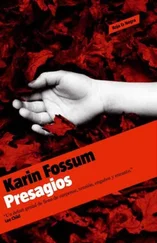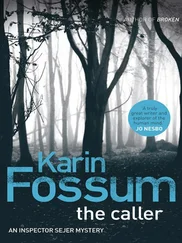Zita accompanied them to the front door.
He stood for a while on the step and tried to excuse his wife.
“We understand that this is hard for you all,” Sejer said, “and we certainly won’t bother you with any more questions. We wish you all the best. And we hope that the youngsters will manage to pull through this without any feelings of guilt.”
Zita walked a few steps down the gravel path and stood with his hands in his pockets, poking at the ground with his toe. “Yes. They’ll get through it. Carmen is pretty solid. When it comes to Nicolai, he just needs a bit more time. But we’ll manage.”
“How did you react when Carmen got pregnant at the age of seventeen?” Sejer asked.
“We were delighted,” he said swiftly. “It’s such a gift, isn’t it? And we thought so highly of Nicolai. We promised to do everything we could to help, and we have. We’ve looked after Tommy for them a lot.”
He looked first at one and then the other.
“I know that you’ve been to the restaurant,” he said suddenly. “Elisabeth called and told me that she’d had to answer some questions. I don’t know what that means, the fact that you wanted to talk to her. But we assume that it’s done now. We don’t have anything else to tell.”
He went back up the steps and then turned to them for the last time.
“I’m sure it’s just your job,” he said somberly. “The fact that you always think the worst. I’m trying to understand that. But you won’t find anything here. It was an accident. There’s nothing more to say.”
Then he disappeared into the house and shut the door with a bang.
“The Women’s Clinic,” Sejer said to Skarre. “I’ve let them know that we’re coming, so they’ll be waiting.”
It was afternoon by the time the two men arrived at Oslo University Hospital. They walked down endless corridors and through wide double doors with glass panels. And then, at the end of a corridor, a sure sign that they were in the right place: a beautiful bronze statue of a stork with a bundle in its beak. They found the staff room and one of the midwives on duty stood up and shook their hands.
“Yes,” she said. “I looked after Carmen. I got your message so I waited. Please, sit down. I’ll be with you in a moment.”
It was a nice, homely room, with a large curved sofa and two armchairs. Flowery curtains in the windows, a large cabinet full of cups and glasses, a coffee machine, a big spacious desk. Two green filing cabinets and a PC. There was a big teddy bear in blue overalls in one corner. Above the desk, a bulletin board was full of photographs of babies in all colors and shapes and cards with messages of thanks from a number of parents. Skarre took off his jacket and went over to have a closer look at the photographs. Thank you for all your help, from Fredrikke. Thank you for looking after me at the birth, from Emilie Krantz. We wouldn’t have managed without you, from Nina and Marie.
The midwife returned after a few minutes, pulled a chair out from behind the desk, and sat down. She was probably in her mid-forties, round, and dressed in a white coat over light pants and white clogs with rubber soles. She immediately inspired trust. Her hair was thick and blond and on her coat she wore a porcelain badge that said ANNE MARIE.
“Yes, I remember her,” she said immediately. “It was a cesarean. She has an extremely narrow pelvis. Oh yes, I remember her, but mostly because her name, Carmen Zita, is an unusual name. Not one you forget really. And she was so young. And the child had Down syndrome. Yes, yes, I remember her well. And the father too, he was almost as young as her and incredibly shy. But I don’t understand why you are here. I don’t see how I can help you; has something happened?”
Sejer looked at the buxom midwife. And it struck him that she was like his wife, Elise. There was something about her hair and eyes, and the warm, assured smile that gave her dimples.
“The child is no longer alive,” he told her. “Tommy drowned in a pond by his parents’ house. We are investing the accident as a matter of procedure.”
She was silent when she heard this, and the warm smile disappeared. She said nothing for a few long seconds, digging her hands deep into the pockets of her white coat. Then she kicked off her white clogs and sat there with bare feet that were small and narrow and golden-brown at the end of a long summer.
“Oh no, that’s so sad,” she said at last. “He was such a great little boy. What age did he get to?”
“Sixteen months,” Sejer said. “He had just learned to walk. But tell me something. He had Down syndrome. How quickly can you see that something is wrong?”
“We see it right away,” she replied. “But we have good training. And Down syndrome is not the worst thing that can happen to a child. They generally grow up into kind individuals, though they often don’t live as long as other people. You could live until you were ninety,” she said with a brief smile. “But people who are born with the syndrome are old by the time they are fifty. If they make it to fifty, which is not always the case. As you know, their appearance is distinct and unmistakable. They are also shorter than most people, and many of them have congenital heart disease. They grow and develop slowly, both physically and mentally. Premature aging and dementia is very common, which is sad but true. And yet they can be a joy to us all. That’s certainly what I think. Don’t you agree?”
“How common is it for a baby to be born with Down syndrome?”
“One in every seven hundred is born with it. Which is actually quite a lot, if you think about it. On average, they live to sixty. They often have a kind of simple wisdom that we others have lost. Something genuine and honest. They are wholly themselves in everything they do and never false in any way. In fact, they make quite an impression and are rather charming. So it always warms my heart to deliver a baby like that. And I’m proud of it.”
“How are they at birth?” Sejer asked. “Tell me, what signs you can see?”
“Newborns with Down syndrome are generally of normal weight and length,” she said, “but they often have what we call low muscle tone. When you pick them up, they feel like a little sack of sand. They’re limp. They lack the muscle tone and suppleness of other newborns. And I can tell you, it was a lot of information for the young couple to take in. We told them that they had the right to care and financial support, as well as extended leave from work.
“There’s a brutal paragraph for pregnant women if they are tested before giving birth. They, of course, dream of having healthy children. Paragraph 2 of the Abortion Act says that they have the legal right to terminate the pregnancy if the fetus has Down syndrome. Which is so sad, but then, that’s life.”
She paused, drew breath, and put her clogs back on.
“And naturally, many parents choose to do that. They can’t face the difficulties it would entail. And anything we can tell them is cold comfort. So it’s a shock, no matter what, and I can understand that. No one has the right to make a moral judgment.”
Sejer nodded. “Did you tell the parents right away when Tommy was born?”
“No, we waited until she had been transferred to the ward and rested a bit. It was the doctor and I who went in. It’s emotionally very demanding, having to tell someone something like that,” she added, “so it’s good if there’s two. You never get used to it.”
“So you remember it well?” Skarre asked.
“Yes, I remember it well. Because of her reaction.”
“What did she say? What did she do?”
The midwife let out a deep sigh. She pulled her hands out of her pockets and folded them in her lap.
Читать дальше












